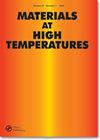Environmentally assisted cracking of a single crystal nickel-based superalloy
IF 0.9
4区 材料科学
Q4 MATERIALS SCIENCE, MULTIDISCIPLINARY
引用次数: 0
Abstract
ABSTRACT Single crystal material, of CMSX-4® alloy composition, was cast and secondary orientation was controlled at the machining stage, to produce c-ring cross-section tubes with known crystallographic orientations. The c-ring tubes were coated with NaCl before being subject to loading up to 700MPa and heated for durations of up to 2 hrs at 550°C in flowing environments containing air and SO2. No cracking was observed in short term tests that were run in the absence of either NaCl, or SO2, indicating a symbiotic interaction is required to initiate cracking. Experiments confirm the presence of oxygen, chlorine and sulphur at the crack tips, formed along {001} crystallographic planes, however, they were distributed discretely, with several oxide and sulphide phases observed. In this work, we image, analyse and identify the phases formed during the cracking and corrosion of CMSX-4® superalloy and hypothesise on the complex chemical interactions that take place during crack initiation.一种单晶镍基高温合金的环境辅助开裂
摘要:采用CMSX-4®合金成分的单晶材料浇铸,在加工阶段控制二次取向,制备出具有已知晶体取向的c形环截面管。C环管在承受高达700MPa的载荷之前涂上NaCl,并在含有空气和SO2的流动环境中,在550℃下加热长达2小时。在没有NaCl或SO2的情况下进行的短期试验中没有观察到裂缝,这表明需要共生相互作用来启动裂缝。实验证实,裂纹尖端沿{001}晶面存在氧、氯和硫,但它们是分散分布的,观察到几种氧化物和硫化物相。在这项工作中,我们对CMSX-4®高温合金在开裂和腐蚀过程中形成的相进行了成像、分析和识别,并对裂纹萌生过程中发生的复杂化学相互作用进行了假设。
本文章由计算机程序翻译,如有差异,请以英文原文为准。
求助全文
约1分钟内获得全文
求助全文
来源期刊

Materials at High Temperatures
工程技术-材料科学:综合
CiteScore
1.90
自引率
15.40%
发文量
58
审稿时长
>12 weeks
期刊介绍:
Materials at High Temperatures welcomes contributions relating to high temperature applications in the energy generation, aerospace, chemical and process industries. The effects of high temperatures and extreme environments on the corrosion and oxidation, fatigue, creep, strength and wear of metallic alloys, ceramics, intermetallics, and refractory and composite materials relative to these industries are covered.
Papers on the modelling of behaviour and life prediction are also welcome, provided these are validated by experimental data and explicitly linked to actual or potential applications. Contributions addressing the needs of designers and engineers (e.g. standards and codes of practice) relative to the areas of interest of this journal also fall within the scope. The term ''high temperatures'' refers to the subsequent temperatures of application and not, for example, to those of processing itself.
Materials at High Temperatures publishes regular thematic issues on topics of current interest. Proposals for issues are welcomed; please contact one of the Editors with details.
 求助内容:
求助内容: 应助结果提醒方式:
应助结果提醒方式:


